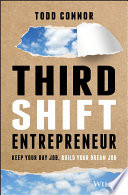

The 'Third Shift' refers to the time outside of traditional work hours that individuals can dedicate to their entrepreneurial pursuits. This book emphasizes the importance of utilizing evenings and weekends to build a business, especially for those who have a full-time job. The concept is rooted in the idea that entrepreneurship does not have to be a full-time endeavor from the start. By leveraging this additional time, aspiring entrepreneurs can gradually develop their business ideas, test them in the market, and make adjustments without the immediate financial pressure that often accompanies full-time entrepreneurship. This approach allows for more calculated risks, deeper learning, and the potential for a smoother transition into full-time entrepreneurship when the time is right.
Continue readingOne of the central themes of the book is the balance between a full-time job and entrepreneurial ambitions. The author shares strategies for managing time effectively, ensuring that neither job performance nor business development suffers. This involves setting clear boundaries, prioritizing tasks, and optimizing productivity during the limited time available. The book also discusses the importance of self-care and avoiding burnout, as the dual demands of a job and a startup can be overwhelming. By establishing a routine that incorporates both work and entrepreneurial activities, readers can achieve a sustainable balance that fosters success in both areas.
Continue readingMindset is a crucial element in the journey of a third shift entrepreneur. The book emphasizes the need for a growth mindset—believing that skills and intelligence can be developed over time. This mindset encourages resilience in the face of challenges and the willingness to learn from failures. The author also discusses the significance of self-belief and confidence in pursuing entrepreneurial goals. By cultivating a positive and proactive mindset, individuals can navigate the uncertainties of entrepreneurship more effectively and remain motivated even when faced with setbacks.
Continue readingThe book advocates for making the most of the resources already at one’s disposal. This includes utilizing skills gained from a full-time job, tapping into professional networks, and leveraging existing technology and tools to minimize costs. The author emphasizes that aspiring entrepreneurs do not need to start with significant capital or resources; instead, they can creatively use what they have to build their businesses. This resourcefulness is essential for third shift entrepreneurs who must operate within limited means and time constraints.
Continue readingNetworking is highlighted as a vital component of entrepreneurial success. The book encourages readers to actively seek out and build relationships with like-minded individuals, mentors, and potential customers. The author provides practical tips on how to network effectively, both online and offline, and stresses the importance of community support. Building a network can provide valuable feedback, encouragement, and opportunities that can significantly impact the growth of a business. The book also discusses the role of social media in connecting with others and fostering a sense of community among entrepreneurs.
Continue readingEntrepreneurship is portrayed as a continuous learning process. The author emphasizes the importance of testing ideas, gathering feedback, and iterating based on what is learned. This approach allows third shift entrepreneurs to refine their business models and offerings without making large upfront investments. The book discusses various methods for gathering customer feedback and the importance of being open to change. By adopting an iterative mindset, entrepreneurs can adapt to market demands and improve their chances of success.
Continue readingThe book concludes with a focus on planning for the transition from a third shift entrepreneur to full-time entrepreneurship. The author outlines steps for evaluating when it might be time to make the leap, including financial readiness, market validation, and personal circumstances. This transition is framed as a strategic decision rather than an impulsive leap, encouraging readers to prepare adequately for the challenges of full-time entrepreneurship. The book provides guidance on how to create a plan that aligns with both personal and professional goals, ensuring a smoother transition.
Continue reading